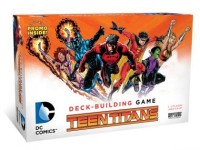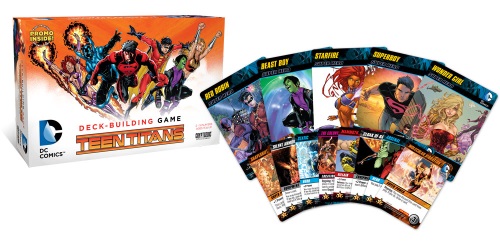
DC Comics Deck-Building Game: Teen Titans

Teen Titans Go!
You’ve played with the old guard. Now play as the youthful up-and-comers. Play as Raven, Beast Boy, Wonder Girl, Red Robin and more. The Teen Titans are all about proving themselves, and with this set you can save your best cards for when you really need them. When you’re ready, unleash everything you’ve got and the results will be spectacular.
The big new focus of the set revolves around Ongoing abilities: Cards that stay in play until you need them. Every time you put an Ongoing card into play, it essentially gives you an extra card to utilize on a future turn. Previously, only Locations and a couple of other cards could ever stay in play. Now every card type at every power level has multiple different cards that are Ongoing. Sometimes they help you every turn. But mostly they stay in play until you choose to discard them for their mighty effects. If you can build up several Ongoing cards, unleash as many as you need to take down the Super-Villains!

This set also pays attention to the different card types you have in play. Playing cards from your hand puts cards into play as usual. But with Ongoing cards out there, you often have several card types in play already. Such synergy!
While this game is a full-fledged standalone game, it can also be mixed with all previous releases in the line.
images © Cryptozoic Entertainment
User Reviews (1)
Add a Review for "DC Comics Deck-Building Game: Teen Titans"
You must be logged in to add a review.


DC Comics Deck-Building Game: Teen Titans is Cryptozoic’s fourth deckbuilding outing using comic book characters. Right away, this base set displays a unity of theme that is largely missing from the earlier sets — all starting Superheroes, as well as cards in the base set and Super Villains, are related to the Teen Titans property. Players may take on the roles of Raven, Beast Boy, Blue Beetle, Wonder Girl, Red Robin, Starfire, Superboy, or Kid Flash (only available as a promo). Based on one of the common lineups of the team in the comics, this leaves out only Aqualad (represented by a Hero card) and Cyborg (who appeared in the first DC DBG set). The starting Superhero card for Starfire marks her third, as she previously appeared as a promo Superhero alongside the Heroes Unite set, and also in the second Crisis Expansion as a Crisis Mode Superhero. The central mechanics of the game remain the same; all of the common setup cards (Punch, Vulnerability, Kick, Weakness) are present, with thematically appropriate artwork.
Teen Titans continues the exploration of mechanical synergy, this time with several cards that feature the Ongoing keyword, and cards that trigger off of that keyword. This is not a new keyword, though the proportion of the set that features it is distinctly higher. Several cards do nothing when put into play, but as an Ongoing, may be discarded from play for an effect. The overall power level of the set is distinctly lower than prior outings; the idea here is that players will consolidate their power by acquiring and putting into play several of the Ongoing cards, which can then be used in tandem on a later turn to generate larger effects, such as taking down Supervillains.
The other major theme involves cards you “control”, either by type or number. Ongoing cards in play count, as well as any cards in your “in-play” area — which include cards you’ve played from your hand this turn. Starfire’s ability to destroy a card you control if you control four or more different card types therefore is quite useful, as you can play a Punch for its +1 Power and then destroy it to thin your deck. Blue Beetle wants to hoard Ongoing cards, as he can draw a card if you control seven or more cards on your turn.
Unfortunately, despite the thematic cohesion and mechanical unification, I find this to be among the weakest products of the DC DBG suite. The problems with Teen Titans as a base set start with its Superheroes. Superboy and Wonder Girl are typical of the type-dependent Superheroes seen in past sets, offering a card draw kicker if you control two or more Super Powers or Equipment, respectively. Raven and Red Robin, on the other hand, are doubly type-dependent: Raven requires you to control two or more Villains to then recurse a Super Power from your discard pile, while Red Robin does the same with Heroes and Equipment. Having abilities that require two entirely separate card types to fully activate is already weak in a deckbuilding game with a central line-up; the unfortunate secondary problem is that both secondary card types for these Superheroes are already “covered” by other starting Superheroes. Gameplay involving both Superboy and Raven, or Wonder Girl and Red Robin, is more likely to end up with one of the players stepping on the other’s strategy directly via normal gameplay (instead of what frequently occurs in other DC DBG iterations, which is “hate-drafting”, where someone will buy a card of a specific type to deny it to a player whose strategy is dependent on that type). Encouraging two or more Superheroes to cover the same ground encourages a form of “hate-drafting” which advances one player’s agenda specifically; doing it in a way that steps on already weak type-dependent Superheroes just seems poorly thought out.
Second is the “left-behind” factor. The need to accumulate Ongoing cards to have explosive later turns, coupled with the lowered power level of the Main Deck cards in general, mean that it is possible for one or more players to be effectively “shut out” of card synergy. In each session which my local group has played with Teen Titans, at least one player is relegated to purchasing marginally useful Ongoings which have poor effects (with Kick cards having been entirely bought out early), or forgoing a turn — and as they fall farther behind, they are unable to capitalize and purchase higher-cost cards which might reverse the trend. The problem seems to be one of utility — by making low-cost cards with not just poor, but nearly useless early effects (Cybernetic Enhancement, for example, which has no baseline Power generation, and requires one Ongoing card to get to the level of “worse than Kick”, making it a terrible card to see early), alongside other low-cost cards that do instantly useful things (Detonator, which is one of the few destruction card effects in the game), the deck development of players can be wildly imbalanced. This tends to make the overall gameplay no fun for at least one player, which is bad in terms of desire to bring the set back to the table.
The considerable downsides are unfortunate, given that Teen Titans does some things very right. The Supervillain Stack setup is excellent, with Slade Wilson as the top Supervillain being the best, most balanced, and most interesting effect of all of the top Stack cards from prior sets. Slade offers an ongoing ability that, while in play, lets you draw your hand back up to five cards at the start of your turn — meaning that all of the discard tech and First Appearance Supervillain Attacks that deplete players’ hands will slide right off of you. The Stack is always meant to end with Trigon, which is thematic to the characters, as he is a primary nemesis to the Titans; as a result, the design on Trigon is such that he has zero use in players’ decks — as the last Supervillain, if he is defeated, the game ends anyway.
The strategy involved in setting up a series of Ongoing cards to have a “power turn” later feels like more interesting gameplay, and would be excellent if the hard imbalances between players’ strategic development were not a nearly-constant factor in games. By making it more difficult to acquire high-cost cards, there is a slower, “set up to win” feel to the game, and that has considerable appeal. Everyone is on an equal footing, more or less, with down-powered cards; the problem is that some cards are more down-powered than others.
I do not have any experience with integrating Teen Titans with any of the other DC DBG expansions; I feel like the low power of the Main Deck would make Crisis Expansions very difficult, but most of the Crossover Packs should be fine. Overall, this core set has more interesting concepts than it has balance, and it suffers for that problem. This set may be the best beneficiary of multiple-set customization, playing around with the Main Deck composition by combining with cards from other core sets.
Pros:
Good integration of theme
Innovative mechanical design
Generally same positives as original
Cons:
Terrible balance of design in starting Superheroes
High “left-behind” factor can shut players out of a game
Few deck-thinning options
DC Comics Deck-Building Game review
DC Comics Deck-Building Game: Heroes Unite review
DC Comics Deck-Building Game: Forever Evil review
DC Comics Deck-Building Game: Rivals – Batman vs The Joker review